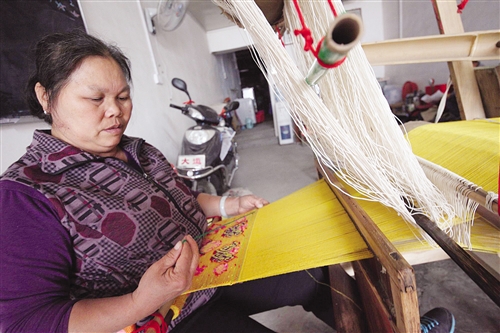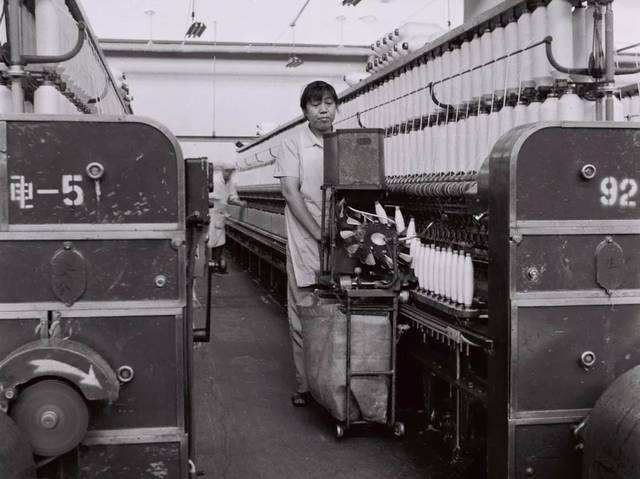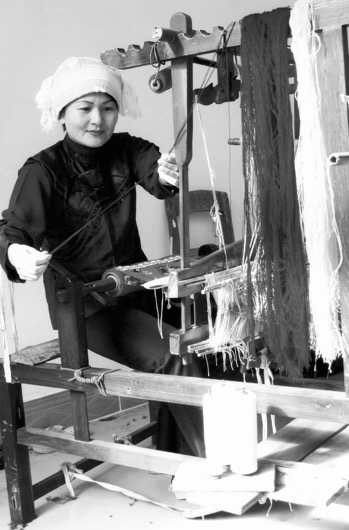The Reform and Opening Up policy adopted by China in 1978 has brought unprecedented productivity and creativity to Chinese society. However, to the surprise of everyone at the time, this progressive policy led to the decline of Zhuang Brocade, the most crucial handicraft in Guangxi.
On July 2, 1994, as usual, Meng Rujun took the brocade weaving after a day of work from the loom, got up, and brushed off the cotton wool on her body, folded the stool, and placed it in the corner. After tidying everything, she turned off the lights, walked out the door, turned and closed the heavy wood door of the Xincheng Zhuang Brocade Factory-this process is what she must do every day after getting off work.
However, that day was different because this was the last time she locked the door of the factory—from tomorrow, the sound of looms would never be heard from the factory. The laughter of the craftswoman chatting in their leisure time would disappear because it had been completely closed.
The Xincheng Zhuang brocade Factory is a three-story reinforced concrete factory located at the end of the Heping Bridge of Shuangsheng River in Xincheng. Between the 1970s and 1990s, it was one of the most reputable and prestigious companies in the county. Before 1975, it was only a rural production cooperative. Later, due to the massive increase in sales of the Zhuang brocade, the production cooperative was officially changed to Xincheng Zhuang Brocade Factory. After the factory was established, the number of employees increased rapidly, and sales continued to rise.
In 1972, Meng Rujun, who had just graduated from junior high school, lied about his adulthood and got a job of a craftswoman at the Xincheng Zhuang Brocade Factory.

“Our family was impoverished at that time,” Meng Rujun said with an embarrassing smile. “After I graduated from junior high school, my family couldn’t afford to pay for me to go to high school, although I had good grades at that time.”
Meng Rujun’s parents are farmers and have almost no income every month. “We didn’t eat rice and only ate sweet potatoes and wild vegetables. Rice was a luxury item for our family.” She sighed. “Rather than putting pressure on my parents, I might as well find a job to make money to support myself so that my parents would not be so tired.”
At that time, the development of the factory was thriving. The annual sales of the factory are increasing steadily. Wu Weifeng, director of the Anthropology Museum of Guangxi, believes that the development of the Zhuang brocade at that stage was related to the local culture.
“The Zhuang brocade is different from other textiles. It is not an ordinary home textile. When a woman from an ordinary Zhuang family gets married, she usually regards the Zhuang brocade as one of the most important dowries. It is virtuous and wealthy for a woman if she could weave the brocade. Because the production of Zhuang brocade requires a lot of cotton, and cotton was a costly textile raw material in that era, if it is bought from a factory, it can also prove that the female family is wealthy.” Wu said. “Under the influence of local culture, Zhuang brocade was not just ordinary textiles for local people, to some extents, every Zhuang family was proud of having Zhuang brocade.”
Fan Miaomiao, a researcher at the Anthropology Museum of Guangxi, makes another point. “In a traditional farming society, the cloth can also be used as currency,” she said. “In a traditional Zhuang society, brocade is equivalent to bringing profits to the craftswomen.”
The development of Xincheng Zhuang Brocade Factory benefited from this culture. Therefore, Meng had no idea that the factory would go bankrupt in the future.
In December 1978, Deng Xiaoping announced at the Third Plenary Session of the Eleventh Central Committee of the Communist Party of China that China had embarked on the path of reform and opening up.

At that time, Meng Rujun and all other practitioners in the Zhuang brocade industry had not realized how much impact this song would have on their lives to change the policy of economic development across China.
In the 1980s, almost all industries in China at that time ushered in a new spring. With the explosive influx of foreign-funded enterprises, advanced modern textile equipment, and cheap polyester, viscose, and other fabrics entered the vision of the Chinese at that time.
At first, Meng and her colleagues were still excited about the new products produced by advanced technology and modern equipment. Nevertheless, gradually, they found that people were beginning to be reluctant to buy the splendour instead of the brocade.
“They are all willing to buy those cheap polyester textiles. After all, those kinds of product offer more choices to customers,” Meng said with a helpless sigh, “I can understand because Zhuang brocade is way too expensive for most people.”
Fan Miaomiao believes that the change in people’s attitude towards the Zhuang brocade is in line with the social development trend at that time. “In the last century, people have not yet begun to emphasize the concept of protecting traditional culture, so even for the Zhuang people themselves, the existence of Zhuang brocade is just an ordinary item for them, and has nothing to do with art.” She Said.
However, with the advent of machines, the rapid development of modern textile technology has made these purely handmade brocades quickly become both expensive and inapplicable. “I think this is ultimately a matter of people’s perceptions,” Fan Miaomiao said. “Because the people who used Zhuang brocade at that time regarded Zhuang brocade as ordinary textiles when modern textile products appeared in front of people, consumers would always prefer those cheap and good quality textiles.”

Wu Weifeng also agreed with this statement. “As a traditional handicraft, Zhuang brocade is uncompetitive in the face of new textiles produced by cheap machinery,” he said. “For them, the Zhuang Brocade is not a symbol of the essence of national culture, but a heavy, expensive, and limited-use commodity with no value for money.”
The sudden social changes shook the entire Zhuang brocade industry. Since then, with the rise of the modern textile industry, the development of Zhuang Brocade as a traditional textile industry has become increasingly ardours.
According to Liu (2000), the focus of textile production shifted to Asia after the 1970s. China began to accelerate the development of the modern textile industry in the 1980s. And after a decade in 1994, China’s total exports of textiles and clothing ranked first globally. In 1998, China’s textile and clothing exports reached 42.88 billion U.S. dollars, accounting for 13.6% of the global textile trade that year(ibid).
In 1986, 14 years after Meng Rujun started to work, she became the director of the Xincheng Zhuang Brocade Factory. However, even with more than ten years of textile experience, she still could not find any way out in the face of tsunami-like modern textiles.
“When I started to take over the Zhuang Brocade Factory, the sales volume at that time was much less than when I first worked, but there were still regular customers,” Meng Rujun said. “But regular customers started to contact us less than before, and until the end, no one came to buy.”
In 1994, the Xincheng Zhuang Brocade Factory was forced to close, and Meng Rujun had to leave the place where she had been for 22 years. “This is my second home.” She said.
Meng Rujun to devote himself to the Zhuang brocade industry 22 years before she was laid off. In these 22 years, she went from being an unknown Weaver Girl to being the director of the factory; she got married, had children, and formed her own family.
“I can’t do anything. I can do nothing but weave brocade. I have to raise my children, and I have to find a way to earn money.” She said.
Although it seems that the decay of the Zhuang brocade is closely related to reform and opening-up policy, Fan Miaomiao believes that this is not directly related to that.
“I think it is not the policy that caused this result, but the public’s choice.” She said. “Although the implementation of the reform and opening-up policy indeed led to the development of the modern textile industry, people did not realize that the Zhuang brocade symbolizes their nation. In my opinion, this is the most significant reason which led to the endangerment of the Zhuang brocade in that period.”
Compared to Meng Rujun, Li Cunling’s experience may be a little luckier.

Li Cunling, 53, has been working in the Zhuang Brocade factory in Jingxi, Guangxi, for 33 years. “After the reform and opening-up, more employees quit their jobs to start their business, and only about 20 craftswomen stayed at the factory to continue weaving the Zhuang brocade,” she said.
Li Cunling thinks she could understand the employees who leave the factory to make a living. “Although I also convinced them to stay and continue to work, I know that many employees who leave are forced to do so,” she said. “I am fortunate. Although the operating conditions of the factory in the 1990s were horrible, my colleagues and I persisted in the end. The factory is still open today.”
The 1990s was the darkest time for the development of the brocade industry. The most famous Zhuang brocade factories in Guangxi at that time closed down one after another, including the Xincheng Zhuang brocade Factory, where Meng Rujun worked. “I knew that the Zhuang Brocade had fallen before I became the factory director. At that time, there were dozens of unsold Zhuang Brocades in our warehouse,” she said. “As a craftswoman, I felt sad.”
To ensure the regular operation of the Zhuang brocade factory, she went crazy trying to find customers for the factory to do business. “I still remember that to complete an order of up to 20,000 yuan, a colleague and I sat on the night bus to Guangdong Province with a bag full of cash. We were so terrified and couldn’t sleep at all because we were worried that the money would be stolen. During the 12-hour journey, the two of us had to stay awake, we didn’t go to the bathroom, or even dared to eat in the restaurant of the service station.” Li Cunling smiled. “The 20,000 yuan in the 1990s could be considered as the 200,000 yuan nowadays.”
To survive, Li Cunling has suffered more than this. Because the employees of the Zhuang Brocade Factory are all women, Li Cunling must act like a strong man and carry dozens of boxes of goods on the truck that every time she delivers goods to customers. After driving to the destination, she also has to unload packages of goods from the vehicle. “Because we have too few employees, we need to participate in everything. For example, procurement, production, marketing, I need to do what I can do and have to do,” Li Cunling said. “I would cry when there was no one. But now, these experiences are just a few stories to me.”
Li Cunling might be the chosen one. Because those glories of the Zhuang brocade in the last century were all gone and forgot by the public. Wu Weifeng signed, “It’s tough to make the Zhuang brocade blooming again in a short time.”
